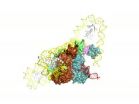(Press-News.org) Plasmodium falciparum, the parasite that causes malaria, has proven notoriously resistant to scientists' efforts to study its genetics. It can take up to a year to determine the function of a single gene, which has slowed efforts to develop new, more targeted drugs and vaccines.
MIT biological engineers have now demonstrated that a new genome-editing technique, called CRISPR, can disrupt a single parasite gene with a success rate of up to 100 percent — in a matter of weeks. This approach could enable much more rapid gene analysis and boost drug-development efforts, says Jacquin Niles, an associate professor of biological engineering at MIT.
"Even though we've sequenced the entire genome of Plasmodium falciparum, half of it still remains functionally uncharacterized. That's about 2,500 genes that if only we knew what they did, we could think about novel therapeutics, whether it's drugs or vaccines," says Niles, the senior author of a paper describing the technique in the Aug. 10 online edition of Nature Methods.
The paper's lead author is Jeffrey Wagner, a recent PhD recipient and current MIT postdoc in biological engineering. Graduate student Randall Platt, recent PhD recipient Stephen Goldfless, and Feng Zhang, the W.M. Keck Career Development Assistant Professor in Biomedical Engineering, also contributed to the research.
Plasmodium falciparum, a blood-borne parasite carried by mosquitoes, is responsible for most of the estimated 219 million cases, and 655,000 deaths, from malaria per year. Treatments include chloroquine and artemisin, but the parasite is becoming more resistant to these drugs.
There is an urgent need to develop new drugs, but potential genetic targets are hard to identify. In animals such as mice, it is fairly routine to study gene functions by deleting a target gene or replacing it with an artificial piece of DNA. However, in Plasmodium falciparum, this approach can take up to a year because it relies on homologous recombination, a type of genetic swapping that cells use to repair broken DNA strands. This occurs very rarely in the genome of the malaria parasite.
"You have to rely on this really inefficient process that occurs only if you have spontaneous DNA strand breaks that happen to fall within your region of interest," Niles says.
Using this time-consuming approach, scientists have been able to identify functions for some of the genes necessary for the parasite to invade red blood cells, as well as some of the genes required for the parasite to later erupt from blood cells. More recently, researchers have successfully used enzymes called zinc finger nucleases to cut out specific genes, but this approach is costly because it requires a new nuclease to be designed for each gene target.
CRISPR, a gene-editing system devised within the past several years, exploits a set of bacterial proteins that protect microbes from viral infection. The system includes a DNA-cutting enzyme, Cas9, bound to a short RNA guide strand that is programmed to bind to a specific genome sequence, telling Cas9 where to make its cut. This approach allows scientists to target and delete any gene by simply changing the RNA guide strand sequence.
As soon as researchers successfully demonstrated that this system could work in cells other than bacteria, Niles started to think about using it to manipulate Plasmodium falciparum. To test this approach, he and his colleagues tried using CRISPR to disrupt two genes, kahrp and eba-175, that had previously been knocked out in malaria using traditional approaches.
The kahrp gene produces a protein that causes red blood cells, which are normally smooth, to develop a knobby appearance when infected with malaria. Niles' team was able to disrupt this gene in 100 percent of parasites treated with the CRISPR system; red blood cells infected by those parasites remained smooth.
With eba-175, which codes for a protein that binds to red blood cell receptors and helps the parasite get into the cells, the researchers disrupted this gene in 50 to 80 percent of parasites manipulated with the CRISPR system. "We consider this to be a win," Niles says. "Compared to the efficiency with which P. falciparum genetics have been done in the past, even 50 percent is pretty substantial."
For both targets, the researchers demonstrated that they could insert a gene for the protein luciferase, which emits light, in addition to turning off the existing genes.
Now that CRISPR technology has been validated in Plasmodium falciparum, Niles expects that many scientists will adopt it for genetic studies of the parasite. Such efforts could reveal more about how the parasite invades red blood cells and replicates inside cells, which could generate new drug and vaccine targets.
"I think the impact could be quite huge," Niles says. "It lowers the barrier to really being more imaginative in terms of how we do experiments and the kinds of questions that we can ask."
INFORMATION:
The research was funded by the National Institute of General Medical Sciences, the National Institute of Environmental Health Sciences, the National Science Foundation, the National Institutes of Health, and the Bill and Melinda Gates Foundation.
An easier way to manipulate malaria genes
New approach to knocking out parasite's genes could make it easier to identify drug targets
2014-08-11
ELSE PRESS RELEASES FROM THIS DATE:
Kessler Foundation scientists link environment & inclusion in adults with disabilities
2014-08-11
West Orange, NJ. August 11, 2014. Kessler Foundation researchers have identified an association between the built environment and disability-related outcomes for adults with physical impairments. The article, Disability and the built environment: an investigation of community and neighborhood land uses and participation for physically impaired adults, was published in the July issue of Annals of Epidemiology (doi: 10.1016/j.annepidem.2014.05.003). The authors are Amanda Botticello, PhD, MPH, and Nicole Cobbold, BS, of Kessler Foundation, and Tanya Rohrbach, MS, of Raritan ...
A global temperature conundrum: Cooling or warming climate?
2014-08-11
MADISON, Wis. — When the Intergovernmental Panel on Climate Change recently requested a figure for its annual report, to show global temperature trends over the last 10,000 years, the University of Wisconsin-Madison's Zhengyu Liu knew that was going to be a problem.
"We have been building models and there are now robust contradictions," says Liu, a professor in the UW-Madison Center for Climatic Research. "Data from observation says global cooling. The physical model says it has to be warming."
Writing in the journal Proceedings of the National Academy of Sciences today, ...
Follow the radio waves to exomoons, UT Arlington physicists say
2014-08-11
Scientists hunting for life beyond Earth have discovered more than 1,800 planets outside our solar system, or exoplanets, in recent years, but so far, no one has been able to confirm an exomoon. Now, physicists from The University of Texas at Arlington believe following a trail of radio wave emissions may lead them to that discovery.
Their recent findings, published in the Aug. 10 issue of The Astrophysical Journal, describe radio wave emissions that result from the interaction between Jupiter's magnetic field and its moon Io. They suggest using detailed calculations about ...
Digoxin tied to increased risk of death in patients with atrial fibrillation
2014-08-11
In An Account of the Foxglove and Some of its Medical Uses, published in 1785, Sir William Withering cautioned readers that extracts from the plant foxglove, also called digitalis, was not a perfect drug. "Time will fix the real value upon this discovery," he wrote.
Now, more than 200 years later, researchers at the Stanford University School of Medicine have validated Withering's warning with the discovery that patients with atrial fibrillation — a rapid and irregular heart rhythm — who are treated with the digitalis-derivative digoxin are more likely to die than similar ...
Bioengineers make functional 3-D brain-like tissue model
2014-08-11
MEDFORD/SOMERVILLE, Mass. (August 11, 2014) --The human brain remains one of the least understood organs in the human body, because of its complexity and the difficulty of studying its physiology in the living body. Tufts University researchers today announced development of the first reported complex three-dimensional model made of brain-like cortical tissue that exhibits biochemical and electrophysiological responses and can function in the laboratory for months. The engineered tissue model offers new options for studying brain function, disease and trauma, and treatment. ...
Trapped atmospheric waves triggered more weather extremes
2014-08-11
It has been linked to a recently discovered mechanism: the trapping of giant waves in the atmosphere. A new data analysis now shows that such wave-trapping events are indeed on the rise.
"The large number of recent high-impact extreme weather events has struck and puzzled us," says Dim Coumou, lead author of the study conducted by a team of scientists from the Potsdam Institute for Climate Impact Research (PIK). "Of course we are warming our atmosphere by emitting CO2 from fossil fuels, but the increase in devastating heat waves in regions like Europe or the US seems ...
Preemies' gut bacteria may depend more on gestational age than environment
2014-08-11
Scientists believe babies are born with digestive systems containing few or no bacteria. Their guts then quickly become colonized by microbes — good and bad — as they nurse or take bottles, receive medication and even as they are passed from one adoring relative to another.
However, in infants born prematurely, researchers at Washington University School of Medicine in St. Louis have found that the population of bacteria in babies' gastrointestinal tracts may depend more on their biological makeup and gestational age at birth than on environmental factors. The scientists ...
Bioengineers create functional 3-D brain-like tissue
2014-08-11
Bioengineers have created three-dimensional brain-like tissue that functions like and has structural features similar to tissue in the rat brain and that can be kept alive in the lab for more than two months.
As a first demonstration of its potential, researchers used the brain-like tissue to study chemical and electrical changes that occur immediately following traumatic brain injury and, in a separate experiment, changes that occur in response to a drug. The tissue could provide a superior model for studying normal brain function as well as injury and disease, and ...
Scientists demonstrate long-sought drug candidate can halt tumor growth
2014-08-11
LA JOLLA, CA – August 11, 2014 – It's a trick any cat burglar knows: to open a locked door, slide a credit card past the latch.
Scientists at The Scripps Research Institute (TSRI) tried a similar strategy when they attempted to disrupt the function of MYC, a cancer regulator thought to be "undruggable." The researchers found that a credit card-like molecule they developed somehow moves in and disrupts the critical interactions between MYC and its binding partner.
The research, published the week of August 11 in the journal Proceedings of the National Academy of Sciences, ...
Elusive viral 'machine' architecture finally rendered
2014-08-11
VIDEO:
The new rendering of the protein-DNA complex, or machine, that the Lambda virus uses to insert its DNA into that of its E. coli host.
Click here for more information.
For half a century biologists have studied the way that the lambda virus parks DNA in the chromosome of a host E. coli bacterium and later extracts it as a model reaction of genetic recombination. But for all that time, they could never produce an overall depiction of the protein-DNA machines that carry out ...
LAST 30 PRESS RELEASES:
Pure bred: New stem cell medium only has canine components
Largest study of its kind highlights benefits – and risks – of plant-based diets in children
Synergistic effects of single-crystal HfB2 nanorods: Simultaneous enhancement of mechanical properties and ablation resistance
Mysterious X-ray variability of the strongly magnetized neutron star NGC 7793 P13
The key to increasing patients’ advance care medical planning may be automatic patient outreach
Palaeontology: Ancient tooth suggests ocean predator could hunt in rivers
Polar bears may be adapting to survive warmer climates, says study
Canadian wildfire smoke worsened pediatric asthma in US Northeast: UVM study
New UBCO research challenges traditional teen suicide prevention models
Diversity language in US medical research agency grants declined 25% since 2024
Concern over growing use of AI chatbots to stave off loneliness
Biomedical authors often call a reference “recent” — even when it is decades old, analysis shows
The Lancet: New single dose oral treatment for gonorrhoea effectively combats drug-resistant infections, trial finds
Proton therapy shows survival benefit in Phase III trial for patients with head and neck cancers
Blood test reveals prognosis after cardiac arrest
UBCO study finds microdosing can temporarily improve mood, creativity
An ECOG-ACRIN imaging study solves a long-standing gap in metastatic breast cancer research and care: accurately measuring treatment response in patients with bone metastases
Cleveland Clinic presents final results of phase 1 clinical trial of preventive breast cancer vaccine study
Nationally renowned anesthesiology physician-scientist and clinical operations leader David Mintz, MD, PhD, named Chair of the Department of Anesthesiology at the UM School of Medicine
Clean water access improves child health in Mozambique, study shows
Study implicates enzyme in neurodegenerative conditions
Tufts professor named Fellow of the National Academy of Inventors
Tiny new device could enable giant future quantum computers
Tracing a path through photosynthesis to food security
First patient in Arizona treated with new immune-cell therapy at HonorHealth Research Institute
Studies investigate how AI can aid clinicians in analyzing medical images
Researchers pitch strategies to identify potential fraudulent participants in online qualitative research
Sweeping study shows similar genetic factors underlie multiple psychiatric disorders
How extreme weather events affect agricultural trade between US states
Smallholder farms maintain strong pollinator diversity – even when far from forests
[Press-News.org] An easier way to manipulate malaria genesNew approach to knocking out parasite's genes could make it easier to identify drug targets






